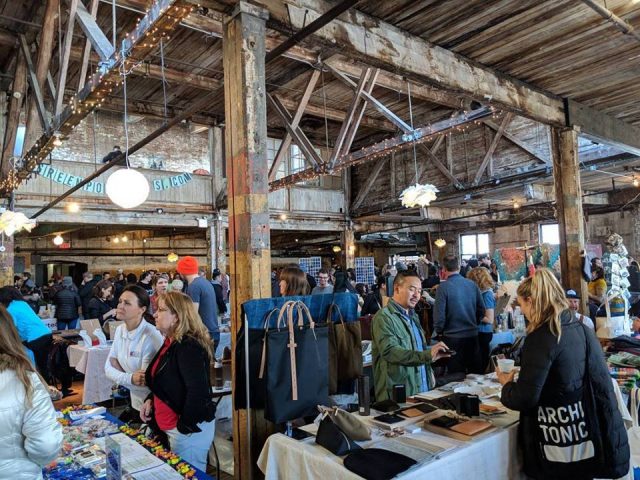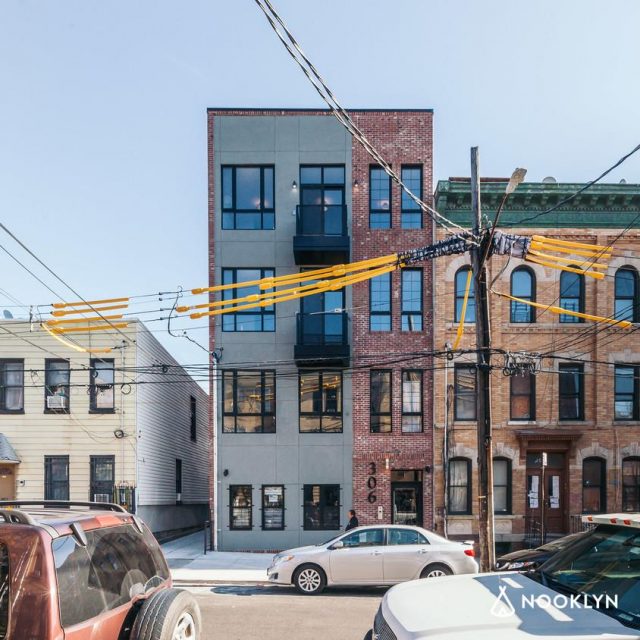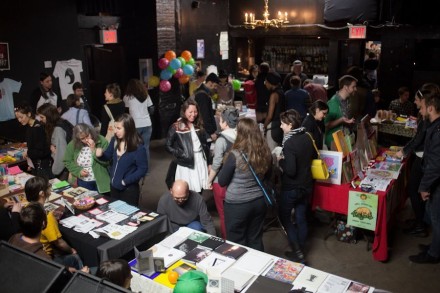
We told you it was happening, and it happened alright: the second annual Brooklyn Zine Fest dropped in to Public Assembly this weekend, drawing more than 80 vendors, a portable library, and hundreds of zinesters eager to pick up the latest issue from their favorite self-publishing poets, illustrators, movie reviewers, foodies, and more. Last year, we spoke to readers of zines to see into the future of the format. So this year, we talked some of the fest’s notable tablers to get the lowdown from those who know how it all started, what to check out, and where it’ll go from here.
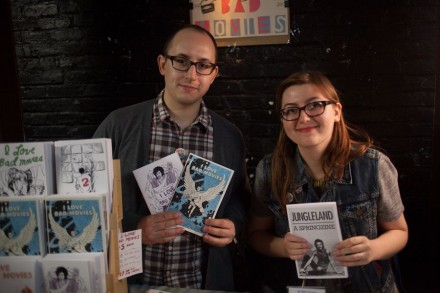
Matt Carman & Kseniya Yarosh, founders & organizers, Brooklyn Zine Fest:
What are your personal histories with zines and zine culture?
K: I have been making zines since college, so, for about the last decade; I used to make personal zines and then in more recent years I’ve moved on to collaborative works like I Love Bad Movies.
M: I didn’t know what zines were until I met Kseniya 6 years ago, and now we’re here.
What’s one thing to know about zines?
M: Just in general? A lot of people think that zines are relics from the 90’s and that they’re “coming back,” but they’ve always been in publication. I think a lot of people just forgot about them. The zines that are coming out today are really well put-together, they’re really well-thought out, and they’re coming out on a range of topics that weren’t covered before. We cover bad movies specifically, and I also have a zine about true-life game show experiences, which is something I’ve never found elsewhere, which is why I made it: I knew a lot of people who’d been on game shows or worked on game shows and I wanted to get all those thoughts together.
What do you think the future holds for zines?
K: Well, like Matt said, zines have existed for a long time and the culture has always been around. I think the Internet has helped people connect a little more. Part of way we’ve met some of the people here is through their websites, or they found us on etsy and they emailed us, so the community definitely benefits from non-paper communication.
M: The Internet didn’t kill zines, it enlivened them, in the end. It’s a way of letting people know about your zine, of spreading the word. We don’t put any of our content online; if you wanna read an essay in I Love Bad Movies you have to pick up a physical copy, but we have a website where we talk about what’s inside, we talk about screenings and things like that, so it sort of reinforces and builds upon the zines that we’re making.
K: And because it’s such a range of topics, you can kind of find something that’s of specific interest to you and go from there.
___________________________________
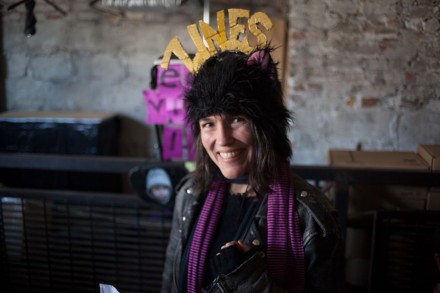
Ayun Halliday, the East Village Inky
How did you get started as a zinester?
I started doing the East Village Inky when I had a daughter. My oldest child was one and I had previously done low-budget, Lower East Side late night-style theatre. When I was pregnant, I was convinced that that happy decade of doing low-budget theatre would just continue on and the baby would sleep in a basket backstage. It quickly became apparent that wasn’t gonna happen, so I was looking for a creative project that could be deeply tied into my identity and could reach strangers as well as friends and it seemed like a zine was about the only thing that was manageable, since whenever the baby conked out, I would whip out the pages that I was working on and write for as long as she was asleep.
Is there anything that you’re particularly excited to see here today?
I really love the Runcible Spoon, I just discovered them when we did an event together at the Brooklyn Museum for a First Saturday. I love Robyn Jordan, who does amazing comics about her life as a teacher and as a Brooklynite relocated to Seattle. The Barnard Zine Library, of course, the head librarian there, Jenna Friedman, has a great reading log that she does. I’m also excited for Brain Frame, which is an import from Chicago that’s a bunch of different comic artists performing their work, usually with slide projections but also in unusual ways, not just reading them out loud, so I’m very psyched for that.
What do you think the future of zines looks like?
I think it will get no bigger and no smaller.You’ll always find about this many people in a large city who are passionate enough about it and individualistic enough about how they want their work to look or to be distributed, and they’re not tech-savvy, or they’re tech-phobic. So I think they will continue.
___________________________________
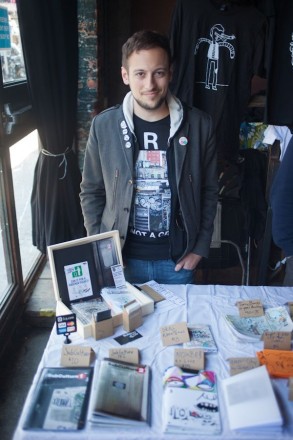
Jowy Romano, SubCulture Zine:
Tell us a little bit about your history as a zinester
Well, it’s funny should ask. My table partner, Ray, does a zine called Carnage, and it was actually his zine that inspired me to create mine. I’ve been doing my website for about 4 years and about a year ago I decided to make my first zine out photos that I originally took intending to put on my website but I though, “Wait, these would make a really good book,” because the photos are of the trashcans in the subway, close-up shots of all the stickers graffiti writers had put on them. They fit the page perfectly, so it made a really nice little zine, and have made two more since then.
And what do you think the digital future means for the zine community?
I think it’s really interesting that zines have been reemerging over the past year or two, just out of nowhere. When the internet started getting bigger, they started going away, and now there’s value in them again in a lot of different ways. There’s value in having a physical thing and there’s also value in having something that’s filtered, because the internet is completely unfiltered and a zine is the opposite of that, it’s exactly what the creator wants it to be.
___________________________________
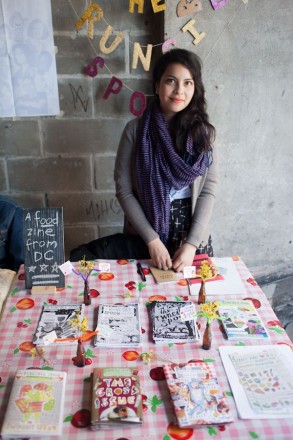
Malaka Gharib, the Runcible Spoon
How did you get into making zines?
When I was 14 I read an independent magazine that I picked up at Skylight Books in Los Angeles, where I’m from, and it said “Anybody can make their own magazine, you can too!” So thought I’d give it a go. I put some papers together and I photocopied it in my uncle’s printing machine and had a zine. I’ve been doing them ever since!
You guys came a long way to be here today, right?
Yeah, all the way from Washington, DC. DC has its own zine fest too, but I’ve discovered so many other zine fests, so I’m thinking about trying to go to as many as I can.
When’s the DC zine fest?
In the summer. It’s a lot smaller than this one, but there’s lots of local stuff. One thing I would like to add about DC is that it has an unfair reputation for being a sort of square town, but a lot of the people who contribute to my zine work for the government or are reporters for Politico [Ed. note: WHAAAA?]. While they have square day jobs, they get to express themselves in a creative way with this.
___________________________________
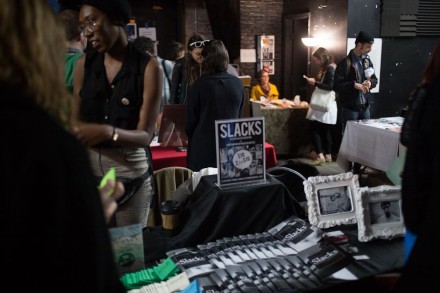
Max, Slacks: A Playful Exploration of Contemporary Masculinity
What does your zine focus on?
The idea was to take photographs of and do interviews with men asking them about their relationship to modern manhood, but to do it in a humorous, light way, not overly academic. I think that’s the way that our generation often talks to each other.
Have you gotten a chance to look around at all today?
Not yet, but I’m really excited to check out Meet the Lady, which I guess is a zine about femininity—I’ll be excited to do some trades with that person!
What do you think the future of zines looks like?
I think it’s really exciting that zine culture is growing so much. Even in the age of Tumblr and Facebook and Twitter there’s a lot of respectability to print and to reading something tangible that’s bounded by time, and I think it’s nice that publishing is dying in one sense but really flourishing in another. I think it’ll be really exciting to see how it continues to grow.
___________________________________
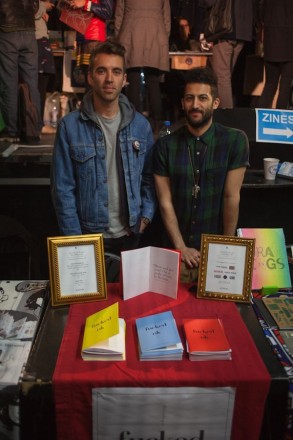
James Aviaz and Andrew Guirguis, Everything is Fucked, Everything is Okay
Why did you start a zine?
I worked in online content for the last 5 years and I got to a point where I started to get a bit bored of everything I was seeing. Having started as a print journalist, I really wanted to go back and experiment with print at a time when that makes almost no sense. Everyone thought I was nuts for doing it and told me start a blog, but there are enough blogs these days. So it’s like, how can we rediscover the magic and the tangibility of what I remember it was like to read great magazines? So that was the motivation for going into print.
What do you think the future holds for zines?
I’m getting the sense that there’s this kind of pushback against a lot of digital stuff, a nostalgic return to print. I think the future of print is pretty strong in this context. I don’t think people are going to be getting advertising revenue like they used to back in the day, but it seems like there are at least as many people here this year as there were last year. So, I think people are sort of yearning for that physical feel.
Leave a Reply


